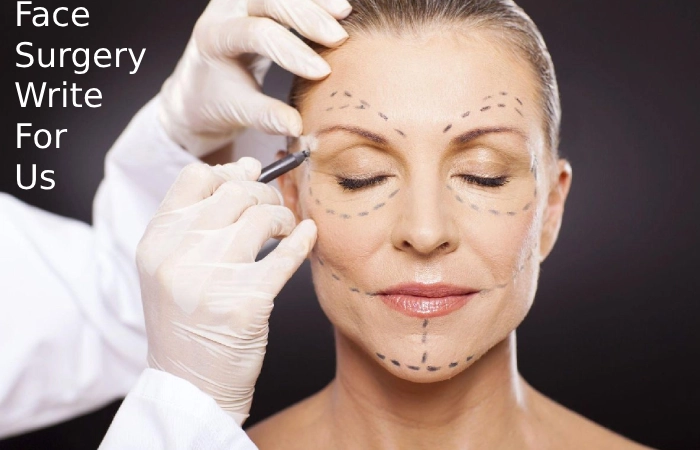Face Surgery Write For Us
Are you a professional writer, or love to write for the face Surgery niche? Who can touch the mind of readers and take our platform to new heights? We provide the option to submit a Face Surgery Write for us guest post to our website
We aim for our writers to bring new topics and publish their unique perspectives. This will not only give recognition to your work which your friends, publishers will read, and the general public, but also boost your potential to touch the reader’s mind through your unique ideas.
How to submit an article
If you’d like to submit an article, please email contact@vigorblog.com
What Is Face Surgery?
Facial plastic surgery performs to reshape structures in the head and neck — typically the nose, ears, chin, cheekbones, and neckline. People looking for this surgery might be interested in reconstructing the face after an injury or disease or changing a feature present from birth. Or they may want to oppose the signs of aging, remove contour irregularities or make the features of the face appear in proportion with one another.
Types of Face Surgery
- Blepharoplasty (eyelid surgery)
- Botox
- Chemical peel
- Chin surgery
- Cheek lift
- Cosmetic dentistry
- Dermabrasion
- Facelift
- Facial contouring
- Otoplasty (ear surgery)
- Rhinoplasty (nose surgery)
- Eyebrow/forehead rejuvenation (brow lift)
- Facial fillers
- Facial wrinkles
- Laser hair removal
- Laser resurfacing
- Neck lift
- Skin problems (blemishes, spider veins, mark revisions, tattoo removal)
- Wrinkle treatment
What are the benefits of face surgery?
 For most people, the benefits of facial surgery balance the risks. There’s a lot you can gain from pursuing these procedures, including:
For most people, the benefits of facial surgery balance the risks. There’s a lot you can gain from pursuing these procedures, including:
- The better worth of life.
- Improved body image and self-esteem.
- Enhanced safety, such as seeing better after removing extra eyelid skin.
- More natural appearance.
- Pain relief and greater independence after correcting defects that make it difficult to move.
- Restored functioning, like eating solid food after recovering from jaw surgery.
What Are The Risks Of Face Surgery?
All surgical procedures come with risks. If your BMI is 30 or higher (obesity) or you have diabetes, you may be at higher risk of developing difficulties such as blood clots in the legs or lungs. Smoking also increases the chances and effects of healing.
Other potential risks of plastic surgery include:
- Abnormal scarring.
- Difficulties of anesthesia, such as respiratory issues during your procedure.
- Fluid build-up (edema).
- Blood clots.
- Blood loss.
- Nerve damage leads to neuropathy.
- The scar avoids natural movement.
- Slow-healing wounds and cuts that take longer than likely to heal.
What Are the Types of Treatment?
 Non-surgical procedures and methods such as chemical peels, microdermabrasion, and injectables can also help with some facial conditions. Injectables include medications such as Botox, Dysport, Restylane, Juvederm, Radiesse, Sculptra, and other fillers that can be placed under the skin to improve the appearance of the face.
Non-surgical procedures and methods such as chemical peels, microdermabrasion, and injectables can also help with some facial conditions. Injectables include medications such as Botox, Dysport, Restylane, Juvederm, Radiesse, Sculptra, and other fillers that can be placed under the skin to improve the appearance of the face.
Surgical facial plastic treatments include:
- Rhinoplasty/Septoplasty—Outside and inside nose surgery in which cartilage and bone are restored and reshaped to improve the nose’s look and function.
- Blepharoplasty—Upper and lower eyelid surgery to improve the process (such as sagging eyelids) and appearance of the eyes.
- Browlift—Surgery to enhance sagging brows and forehead creases.
- Rhytidectomy—Skin tightening and wrinkle removal surgery performed on the face and neck.
- Liposuction—A surgical procedure used to remove extra fat under the chin or in the neck.
- Facial Implants—Surgery to make specific facial structures (cheek, lips, chin) more prominent and defined.
- Otoplasty—A procedure that reshapes the cartilage of the ears to make them protrude less.
- Skin Surface Procedures—Surgery that uses lasers, chemical peels, or derma-abrasion to smooth the skin.
- Facial Reconstruction—Surgery to reconstruct defects in facial skin from prior surgery, injury, or disease, including reconstruction resulting from cancer surgery, scar revision, repair of previous facial trauma, removal of birthmarks, and correction of congenital abnormalities of the skull, palate, or lips.
Why Write for Vigorblog – Face Surgery Write For Us
- Writing for vigorblog can give massive exposure to your website for customers looking for Face Surgery.
- Vigorblog presence is on social media, and we will share your article for the Face Surgery related audience.
- You can reach us out at contact@vigorblog.com
Search Terms for Face surgery Write for Us
Face surgery Write for Us
Write for Us Face surgery
Face surgery Guest Post
Guest Post Face surgery
Face surgery Contribute
Contribute Face surgery
Face surgery Submit Post
Submit Post Face surgery
Face surgery submit an article
Submit an article Face surgery
Face surgery become a guest blogger
A guest blogger Face surgery
Face surgery writers wanted
Wanted writers Face surgery
Face surgery suggest a post
Suggest a post Face surgery
Face surgery guest author
Guest author Face surgery
Guidelines For Guest Posting
- Write error-free, plagiarism-free, and well-formatted articles.
- Content should be unique, spelling checked and make sense.
- Pick the trending subject or topic that matches the stuff we publish.
- Avoid spam or broken links in the content.
- Do not use words or statements that are unnecessary. Use attractive words instead.
- We will not publish articles with incorrect data.
- Add copyright-free images of high-resolution at least 1 (Mandatory).
- Minimum 800 words in length.
- Articles must be related to our categories or target audience. We don’t publish irrelevant categories.
- Do appropriately interlink our articles.
You can send your article to contact@vigorblog.com

